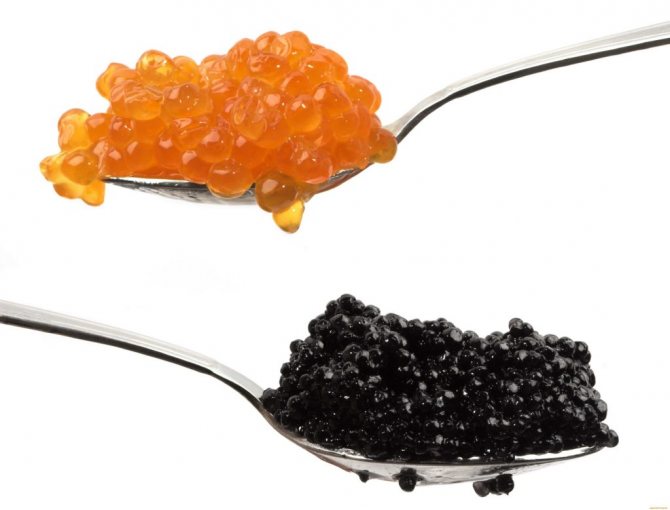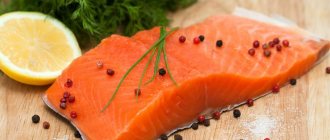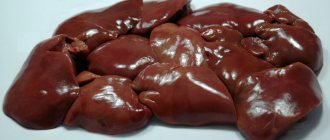Breast milk is the most balanced form of nutrition for a newborn. It is important for nursing mothers to correctly plan their diet for every day in order to fill the baby’s body with the necessary elements, avoiding a deterioration in the child’s well-being. During feasts, mothers are often interested in the question of whether red caviar can be consumed while breastfeeding and, if so, in what quantity.
Red caviar during breastfeeding is a controversial product. In this regard, it can be used, but within reasonable limits, very carefully monitoring the child’s condition.
Types of red caviar
Red caviar is a healthy seafood product that contains nutritional elements that have a beneficial effect on human health. It is a natural source of protein. The element promotes energy production and has a rejuvenating effect.
Red caviar does not contain harmful fats and carbohydrates. It contains mineral salts, folic acid, vitamins B, A, E, elements - zinc, potassium, phosphorus, calcium, magnesium, biologically valuable substance - lecithin.
The protein that is part of caviar is easily digestible and does not cause heaviness in the stomach, unlike proteins found in meat products or fermented milk products.
There are different types of red caviar, in particular caviar:
- trout - orange with a red tint, eggs of a dense structure, up to 3 mm in size, have a pleasant taste, the consistency of the product is viscous;
- sockeye salmon – large, up to 5 mm, distinguished by a rich red color, the shell is soft, and after eating it leaves a bitter aftertaste;
- coho salmon is a rare and healthy type of caviar, it ranks first in vitamin composition and vitamin D content. Indicated for consumption by the elderly, children over 3 years old, mothers during lactation, as well as anyone who needs to strengthen the immune system;
- pink salmon - a popular and versatile species of the salmon family, the eggs are large, rich carrot color, the taste is delicate, sweetish;
- chum salmon - has an original red tint, soft structure, ideally shaped eggs, up to 6 mm in size.
On store shelves there is black caviar from sturgeon fish, pink caviar from pollock and cod eggs. Tobiko is flying fish roe, colorless, used to make rolls, changes color when spices are added. There is an artificial product on sale that imitates natural caviar in taste and appearance, containing proteins and gelatin.
How to choose pollock caviar
Not everyone here knows how to choose canned food, and many people simply do not attach importance to this, and in vain. It is better to choose caviar in glass jars - you can see it right away, and you can already determine the quality by the color: good pollock caviar is light beige or almost white, but not bright pink, yellow or orange - the “color” comes from dyes. In the jar, the eggs lie tightly, without any liquid, forming an almost homogeneous mass in the form of a kind of puree.
You can also take tin cans: then you will have to check the product “for taste and color,” as well as for smell, after opening the container; the taste and smell are fishy, without any impurities.
In any case, you need to carefully read the ingredients: it only seems that caviar is caviar, but manufacturers prepare canned food in different ways. The best composition is caviar and salt, possibly also vegetable oil, but several “E-shek” can also be added to the mass: E412, E415, E211, E635, etc. The first two additives are thickeners, guar and xanthan gum, are introduced for ensuring product viscosity; they are considered safe and even somewhat beneficial - for example, E412 can reduce the level of saturated fat. Sodium benzoate - E211, is also relatively harmless if you do not consume it too often, and this is not easy to do - many foods are now “rich” in preservatives - but E635, a flavor enhancer, often causes stomach and intestinal upsets, although it is recognized safe for health.
The benefits of caviar during breastfeeding
Eating natural red caviar during lactation has a beneficial effect on the body of mother and child.
Benefits of caviar during lactation:
- mental activity improves;
- the risk of heart disease is reduced;
- intestinal function is normalized;
- waste and toxins are removed from the body;
- visual acuity is maintained;
- blood circulation increases;
- the mother’s hormonal levels are stabilized, which reduces the risk of postpartum depression;
- immunity is strengthened;
- the functioning of the nervous system improves;
- the salt balance in the body is normalized;
- The thyroid gland functions effectively.
Moderate consumption of red caviar helps reduce bad cholesterol and renew tissue at the cellular level. Additionally, the skin is rejuvenated, the structure of the nails and hair shaft is improved, and the number of facial wrinkles is reduced.
Red caviar replenishes hemoglobin deficiency in the blood, prevents the development of anemia, and restores vitality.
The product lifts your mood and helps cope with depression or panic attacks after childbirth. The calorie content of the delicacy is 249 kcal per 100 g of product. A tablespoon of caviar contains a daily dose of essential elements.
Harm to caviar during lactation
The main risk of eating red caviar while breastfeeding is an allergy to the product. The child may experience a rash, colic, nausea, itching, peeling and redness of the skin. The second aspect is that excessive saltiness changes the taste of milk, as a result the child may refuse to breastfeed. And third, the delicacy can aggravate the mother’s condition if she has swelling, renal/liver failure, ischemia, high blood pressure, or urolithiasis.
Is it possible to spawn caviar during breastfeeding or not? Experts are confused. Some argue that introducing the delicacy into the diet before 6 months is a risk for the child, while others recommend the product to improve the condition of the mother and baby. But all the statements of scientists come down to one thing - the game should be used within reasonable limits and only of high quality.
A counterfeit product may contain a life-threatening element - methenamine, which is used to extend the shelf life of the product. After a few months, the carcinogen dissolves in the product and turns into poison. The accumulation of such an element in the body causes malfunctions in the liver, kidneys, cardiac and nervous systems.

Red caviar is a product that should not be included in the menu of a nursing mother in the first month after the birth of the baby.
How to store?
Usually, the entire contents of even the smallest jar are not eaten at one time. For a young mother it can last for a whole month. In this case, it is important to know how to properly store this seafood.
After the jar of caviar has been opened, you need to transfer it to a glass container. This is necessary, since the metal, when interacting with air, can oxidize and spoil the product. The delicacy can only be stored in the refrigerator in a hermetically sealed jar.
Of course, it is advisable to eat all the caviar at one time. A nursing mother can eat a couple of teaspoons, and the rest can be eaten by the family. So, you don’t have to worry about proper storage of your favorite product.
Fish caviar is a healthy and nutritious product, especially black and white caviar.
Processed and salted fish eggs of various breeds are a delicious delicacy that is usually eaten with bread, pancakes, decorated with salads or added to various snacks.
But during the period of breastfeeding, every woman tries to follow a certain, sometimes quite strict, diet.
And not everyone knows whether fish caviar can be consumed during lactation and why.
Introduction of caviar into the diet during breastfeeding
It is recommended to try the red game for the first time no earlier than 4-6 months after the birth of the child. It is imperative to monitor the condition of the baby for 2 days. In the absence of colic, redness and rash on the skin, you can increase the dosage from 5 to 15 g per day.
The first portion is half a teaspoon. It is best to make a sandwich using whole grain bread and butter. Then use 2-3 times a week, spread on bread or add to salads and sauces.
The product should be introduced into the diet in the absence of dishes unfamiliar to the baby in order to accurately track the child’s reaction to the delicacy.
The main thing is to choose a high-quality product to avoid toxicity to the body. When eating caviar, there is a risk of getting worms, which is not only undesirable but also dangerous when breastfeeding.
Recipes with pollock caviar
In addition to salads and rolls, with caviar you can prepare a well-known appetizer of lavash in the form of rolls. For a jar of caviar you will need 100 g of mayonnaise (light), boiled eggs (4 pcs.) and a bunch of fresh herbs (dill, etc.). Grate the eggs and mix with finely chopped herbs. The pita bread is unrolled, thinly coated with mayonnaise, then evenly coated with caviar, a mixture of eggs and herbs is also placed on top, the roll is carefully rolled up and put in the refrigerator for an hour. The chilled roll is easily cut into thin portioned “circles”.

Photo: pollock caviar
An interesting appetizer can be quickly and easily “created” from caviar and olives. Buy a jar of the largest (60/80) pitted olives (Atlas or Kalamata can be used), cut off the top, fill the olives with caviar mixed with olive oil (put a few chum salmon eggs on top, if you have them), and put the “lid” on place. Unexpected guests can be surprised by the simplicity and originality of such a dish.
In Russian cuisine, the recipe for pancakes with red caviar is well known, but pancakes can also be served with pollock caviar sauce: it also turns out original and tasty. Prepare pancakes as usual - according to your favorite recipe, and for the sauce, mix fresh cucumber grated on a coarse grater with sour cream and lemon juice. The mixture should not be too liquid; a jar of caviar is added just before serving. If desired, you can add finely chopped green onions to the sauce.
By the way, pollock caviar goes especially well with fresh cucumbers. You can make cucumber sandwiches with it: caviar mixed with olive oil and chopped boiled eggs is placed on slices of cucumber cut lengthwise - the benefits are much greater than from options with white bread or a loaf.
Selecting a quality delicacy
When choosing red caviar, it is important to pay attention to the following factors:
- preferably the product is in a glass container so that the buyer can examine the contents;
- in a tin container, look at the lid to avoid swelling and damage;
- when shaking the jar, the caviar should not gurgle;
- check the product labeling on the lid;
- check the timing of production and sale of the product;
- pay attention to the presence of greasy stains: such a product is taboo;
- the price equivalent should not be underestimated;
- familiarize yourself with the composition: acceptable options are caviar, salt, no more than 2 preservatives.
- eggs, uniform in color, uniform, without excessive amounts of water and fat.
Preference is given to products from world-famous companies. When choosing a delicacy, the buyer should be wary of the low cost of the product, ideal-sized eggs, pungent odor, viscosity of the product, vacuum or plastic packaging.
Natural red caviar crumbles when stirred, does not contain mucus or plaque, and emits a moderate fishy odor. When the product is placed in hot water, grains of real caviar do not dissolve, unlike artificial protein.
The product must be stored in the refrigerator after opening the container for no more than a week. After each use, the packaging must be sealed. It is recommended to transfer caviar from an iron can to a glass container to avoid oxidation of the product.
Poor-quality red caviar can cause serious poisoning, which is fraught with health problems for both the mother and, first of all, the baby. An alternative to this product would be squash caviar - affordable, tasty and no less healthy. The dish is easy to prepare at home. Can be used from the first month of birth of the baby.
Recipes with pollock caviar
Fresh pollock caviar is prepared in the same way as the caviar of other fish: you can fry it directly in yastyks (film bags), add it to fish soups and other dishes. However, a more common product is canned caviar, and with its help you can successfully diversify your home menu, if you don’t stick to sandwiches, but show a little creativity.
Popular rolls today can also be prepared with pollock caviar, combining it with fresh cucumber and melted cheese.
Many people don’t like this caviar because of its bitterness, but this can be easily overcome if you add 1 tsp to the jar. olive or sunflower oil, mix and put in the refrigerator overnight - the taste will become noticeably softer.
You can also salt fresh caviar at home, clearing it of films. For 1/2 kg of caviar 2 tsp. salt and 1 tsp. sugar, 1 tsp. butter and 1/2 tsp. lemon juice. Mix everything and put it in the refrigerator overnight – you can eat it in the morning. Such caviar, if it was actually purchased fresh and of high quality, is tastier and safer than many store-bought canned goods.
Black caviar during breastfeeding
Black caviar is more expensive than red caviar, and its composition is more valuable. Contains magnesium, calcium, potassium, zinc, phosphorus. Normalizes water and hormonal balance, strengthens the skeletal system, increases the body's protective functions.
The first time you introduce the product into the diet is from a couple of eggs. Use in the first half of the day, and then monitor the child’s condition. You should not introduce black caviar into the menu until six months after the baby is born.
Black caviar contains polyunsaturated fatty acids, which help activate fat metabolism. The calorie content of the delicacy is up to 250 Kcal per 100 g. If there is a deficiency of iron in the body, this is an irreplaceable product.

The danger of any type of seafood is that you can purchase a low-quality product, and therefore you need to be scrupulous in the process of choosing a delicacy.
Caviar is a healthy seafood product, the main thing is to consume it in reasonable doses and monitor the child’s condition. In the absence of contraindications, this delicacy will saturate the mother and baby’s body with essential vitamins and microelements, giving a great mood, a surge of vigor and strength.
Is it allowed in baby food?
Due to its high nutritional value, this product of the fishing industry is especially popular. Pediatricians allow caviar to be included in children's diets. But before this, it is necessary to introduce the child to boiled and stewed fish of various breeds. This way, his body will subsequently react more favorably to the appearance of a new fish product in the diet.
Fish caviar can be included directly in a child’s diet no earlier than the child turns 3 years old. But this is only in those cases where he had not previously experienced a negative reaction of the body to the introduction of other new food products.
If your child has a tendency to develop food allergies, then you can give him the first taste of caviar no earlier than at age five.
It is also possible to introduce caviar from river fish into the diet no earlier than the child turns five years old. If he has a tendency to allergies and serious digestive problems, then he should postpone introduction to this food product until he is 7 years old.
Just like breastfeeding women, small children can eat caviar only in lightly salted form. It is necessary to choose pasteurized products. It is safer for a growing organism. It is advisable to serve caviar not as an independent dish, but as the main protein product for lunch in combination with complex carbohydrates.
The benefits of fish caviar for a growing body are quite impressive:
- saturation with almost all useful microelements;
- supplying the body with substances necessary for normal development - iodine, iron and potassium;
- it stimulates active brain function and helps increase attention;
- actively strengthens the immune system.











